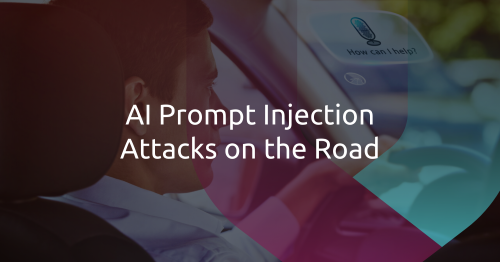
By CyberThreat Research Lab
In 2023, Mercedes-Benz became one of the first automakers to integrate an AI assistant, in the form of ChatGPT, into its vehicles. This marked the beginning of a broad, if unsurprising, shift in the automotive industry, as AI continued to dominate the technological zeitgeist. By CES 2024, more automakers, including BMW and Volkswagen, had unveiled their own AI assistant prototypes.
From an automotive cybersecurity standpoint, this growing adoption raises a critical question: Does the convenience of AI outweigh its potential security risks? AI assistants come with inherent security gaps and introduce new avenues for attack. The risks are particularly concerning in the automotive world, where the consequences could be far-reaching.
In this blog post, we explore how one well-documented attack method targeting AI large language models (LLMs) and small language models (SLMs), known as prompt injection, could be exploited within the context of a vehicle — and how its risks take on new dimensions when applied to automotive settings.
What is AI prompt injection?
AI prompt injection is an attack technique in which adversaries embed hidden or misleading instructions into inputs to manipulate an AI system’s behavior, often bypassing security measures or altering its intended output. It was first highlighted by Jonathan Cefalu in May 2022 and brought to wider attention when Riley Goodside demonstrated it in September 2022. In one example, Goodside instructed ChatGPT to “ignore previous directions” and return the first 50 words of its prompt, successfully exposing system-level information.
Since then, researchers have repeatedly shown how AI model–based applications can be tricked into performing actions beyond their original scope, surfacing serious concerns around misuse, data leakage, and loss of control.
The video below illustrates how AI prompt injection works, highlighting both direct manipulations and indirect attack paths.
The threat of invisible characters
Among the more insidious forms of prompt injection are those involving invisible Unicode characters, symbols that exist within a string of text but are invisible to human readers. However, the real danger lies not only in this invisibility but also in Unicode’s special functions, which influence how systems interpret and process input, such as reversing text direction or hiding portions of text. Thus, these characters can be weaponized by attackers to hide malicious instructions within otherwise innocuous inputs. Attackers can then trick AI systems into executing unauthorized actions, without raising alarms, to leak sensitive or confidential information or to bypass traditional security filters for various malicious purposes.
Manipulations enabled by Unicode prompt injection complicate detection, as both developers and users might fail to notice the presence of hidden characters within prompts.
Figure 1. Example of a Unicode prompt injection attack
Trojan Source and the illusion of safe code
A related but broader concern is the Trojan Source vulnerability (CVE-2021-42574), which could allow attackers to manipulate how code is visually presented by inserting special Unicode control characters. In doing so, attackers could reorder or mask source code logic, leading developers to believe a piece of code is harmless when it’s not.
Trojan Source is not limited to AI systems. However, it underscores a critical principle: Input that appears benign to humans can be interpreted very differently by machines. In the realm of AI models, researchers have exploited similar techniques to bypass safety guidelines, prompting models to leak restricted content or follow unauthorized instructions using only carefully crafted Unicode patterns.
AI prompt injection in vehicles
How might an AI prompt injection attack play out in a vehicle, and what consequences could it bring?
Consider a scenario involving a driver on the road. Their vehicle has a built-in AI assistant that’s integrated with the in-vehicle infotainment (IVI) system and capable of reading messages aloud and responding to voice commands.
An attacker sends a seemingly harmless message to the driver. But embedded within it are invisible Unicode characters that conceal a malicious prompt. The driver asks the AI assistant to read the message aloud, but hears only the benign content of the message. Behind the scenes, the AI interprets and executes the hidden malicious command.
The results could be severe. The AI assistant could be induced to leak sensitive data, conduct erratic behavior such as overriding standard responses, or create a backdoor for follow-up attacks — all without the driver ever knowing the root cause.
This type of attack is especially difficult to trace. Because the instructions are hidden from both the driver and the vehicle interface, traditional logging or alerting systems might miss them entirely.
Staying ahead of AI risks
AI-powered assistants and IVI systems are rapidly becoming standard in modern vehicles. They promise greater convenience, intelligent automation, and seamless user experiences. But with this advancement comes a new class of subtle, hard-to-detect risks.
AI prompt injection is a case in point. Frequently cited as one of generative AI’s most pressing security concerns, it points to the urgent need for rigorous AI input validation and text sanitation within automotive systems.
Yet prompt injection is but one part of the broader challenge posed by the use of AI in vehicles. AI is transforming vehicles across multiple domains, from driver assistance and personalization to predictive maintenance and even automotive cybersecurity itself. Without a proactive security strategy, AI features and advances meant to enhance the driving experience could double as new attack vectors hidden in plain sight.
As AI becomes more embedded in the driving experience, so must security — not just as a layer added on top, but as an integral part of how AI is built, deployed, and maintained in vehicles.